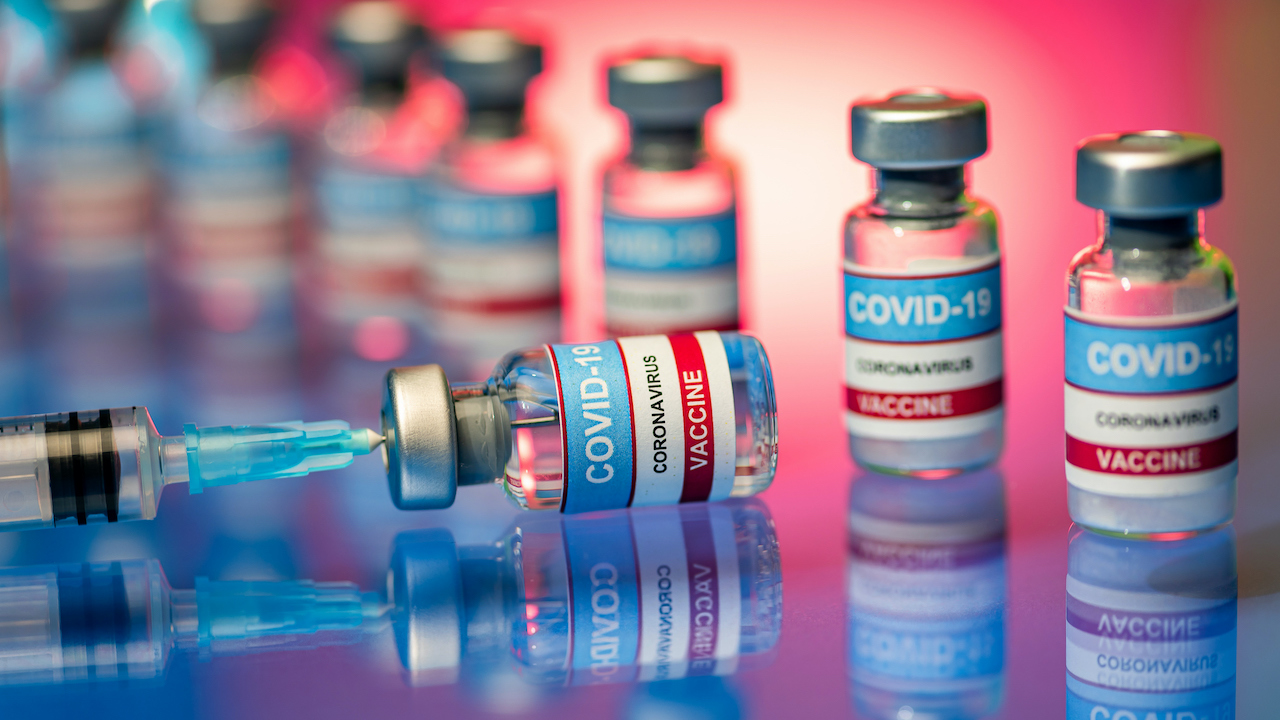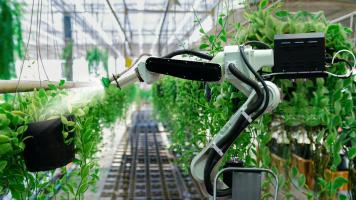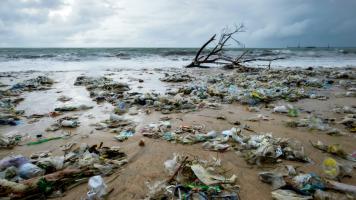
As of end-March, about 521 million doses of the COVID-19 vaccines have been administered worldwide. Photo credit: iStock/Toshe_O.
To turn the tide against the pandemic, all hands should be on deck.
For some remote areas in the Philippines, Viet Nam, or anywhere else in Southeast Asia, a drone may well be the best bet to safely deliver vaccines to inoculate people against the virus that causes the coronavirus disease (COVID-19).
It is a scenario the Asian Development Bank (ADB) is studying to help countries reach remote areas, said ADB Vice-President for Knowledge Management and Sustainable Development Bambang Susantono during his opening keynote on the second day of the recently concluded Southeast Asia Development Symposium (SEADS).
Using drones is just one of the high-tech solutions being considered and deployed across the world to make sure vaccines are distributed as widely as possible. Now that countries in the region have started to roll out vaccination programs, authorities are relying on a combination of high-tech and old-school strategies to reach their citizens in the safest and quickest way possible. But whatever solution is being deployed to reach herd immunity, the consensus seems to be all hands should be on deck.
Southeast Asia is racing against time and the spread of the new variants so the pandemic would not further hurt their economies. Already, Susantono said Southeast Asia’s gross domestic product (GDP) is projected to contract by 12.7% in 2020 and by 11% in 2021. “This equals to GDP losses of $374 billion in 2020 and an additional $322 billion this year. The pandemic affected the jobs of 30 million people across the region with unemployment rising to 7.1%.”
Amid the grim outlook, the rollout of vaccines brings optimism, he said. “We just hope that widespread vaccine distribution will happen soon to help ‘steady the ship’ and bring the pandemic under control. Once vaccination is underway, countries can then intensify their focus on a post-pandemic recovery.”
Indeed, governments are pinning their hopes on the rollout of the vaccines to finally be able to turn the tide against the pandemic. But they also face many challenges to achieve herd immunity as they continue efforts to contain COVID-19 while making sure the new variants do not get more of a toehold. As of 30 March, confirmed cases in Southeast Asia were inching toward 15 million with deaths at 218,604.
The challenges facing Southeast Asia are varied and complex, ranging from insufficient vaccine supply and inadequate logistics to vaccine hesitancy, vaccine nationalism, and preventing future pandemics, according to SEADS 2021 keynote speakers and panelists at the plenary session, “Immunization for All: Providing COVID-19 Vaccines across Southeast Asia.”
Vaccine supply
Getting enough supply is one of the biggest challenges for countries in Southeast Asia as developed countries had cornered bulk of the vaccines already available. A report by the Economist Intelligence Unit said that of the 12.5 billion doses major vaccine producers committed to produce in 2021, 6.4 billion were pre-ordered mostly by developed countries.
Jerome Kim, director general at the International Vaccine Institute (IVI), said the world needs 10 billion to 12 billion doses in order to vaccinate enough people to achieve herd immunity. As of 28 March, only about 521 million doses have been administered, according to the World Health Organization (WHO).
For the Philippines, Health Undersecretary Myrna Cabotaje said the government has entered into bilateral deals with vaccine manufacturers to source supply. The government is also counting on donations from other countries and COVAX to fill some of its requirements. COVAX, the WHO-led initiative that aims to secure at least 20% of countries’ populations, targets to deliver at least 2 billion doses by the end of the year, including at least 1.3 billion doses to 92 lower-income economies.
The Philippines is looking to immunize 50 million to 70 million people out of its 110 million population by the end of the year.
“We are challenged with a very big population to immunize and the problem of availability of vaccine,” said Cabotaje.
Indonesia also has a large population to immunize. It is targeting to vaccinate 181.5 million, or more than 60% of its population of 270 million. “We strongly believe that vaccination is one of the critical steps that we have to overcome to erase this pandemic,” said Health Minister Budi Gunadi Sadikin during his keynote message. To turn the tide against the pandemic, apart from vaccination, Indonesia will also improve public health systems, tighten diagnostic and surveillance protocols to reduce transmission, and strengthen therapeutic and treatment facilities for those infected.
Serum Institute of India Executive Director Suresh Jadhav conceded that current supply is tight. Serum Institute has so far supplied 59 million doses of the COVID-19 vaccine to more than 71 countries. In India alone, it has supplied 66 million doses, of which almost about 40 million doses have been used.
But Jadhav said that apart from Serum Institute of India other manufacturers are adding capacities to make the vaccine. “I am quite confident that by the end of 2021, there will be more than two to three billion doses capacity, which will be available globally. That will certainly ease out the sort of difficulties that the countries are facing on how to procure a sufficient quantity of the vaccine.”
Assuming the new COVID-19 variants will not lead to spikes in infection, the speakers agreed that once supply improves, the world may be able to return to "somewhat normal" by late 2022 or early 2023.
Inadequate logistics
Distributing the vaccines once they arrive in the country is a challenge, not just in terms of availability of transport to reach the last-mile communities, but of making sure the jabs are stored in ultra-freezing temperatures needed to make sure they remain potent. Logistics is a particular problem for both Indonesia and the Philippines as both are made up of islands.
Recognizing insufficient cold-chain storage capabilities of some of the countries in Southeast Asia, where some areas do not have electricity, ADB’s Health Sector Group Chief Patrick Osewe assured that ADB is ready to support member countries to address these gaps.
He said that ADB had allocated $9 billion to support member countries to obtain and to deploy vaccines and is working with governments to assess and bolster their preparedness.
In particular, arrangements for cold-chain logistics are being assessed as some of the vaccines require storage temperatures of -70° to -20° Celsius or 2° to 8° Celsius.
Vaccine hesitancy
Making sure citizens agree to get the jabs is another challenge. “You can have all the vaccines but if the population is not ready, they might not come to be vaccinated. So what kind of system… and communication do you put in place to ensure that people are actually vaccinated when the vaccines are available,” noted Osewe.
Ruth Karron, a professor at the Johns Hopkins Bloomberg School of Public Health and director of the Center for Immunization Research, noted that vaccine hesitancy would need to be addressed for any vaccination program to be successful. “We won't turn the tide of the pandemic until we convince people to take these vaccines.”
One way to build confidence is to persuade health workers to get the vaccine. Another is for scientists to partner with trusted community and faith leaders about conveying the right message to their constituents about vaccines and address mistaken beliefs. This is also true for conveying messages through the media, she said.
Open communication is important, Karron stressed, even on matters scientists may not yet have a clear answer for. “It’s really important for us to say what we know and what we don't know… to really be completely transparent.”
Vaccine nationalism
Some developed countries’ efforts to exert control on the supply of vaccines or the materials and goods needed to make them could also potentially stymie efforts to ramp up production.
Jadhav conceded it could make production challenging down the road. But in the next 5 to 6 months he does not anticipate problems as the Serum Institute had already procured enough materials for production.
Jin Seon Park, Vice-President for Global Business Development at drugs firm SK Bioscience, said that in ordinary times vaccine nationalism is an issue. At the same time, she is heartened by the collaboration she has seen among pharmaceutical companies in developing the vaccines and in sharing their technology with other manufacturers. She also anticipated countries localizing vaccine production by providing incentives to manufacturers.
Future-proofing against more pandemics
Having seen the devastation brought about by COVID-19, both Kim of IVI and Richard J. Hatchett, CEO of the Coalition for Epidemic Preparedness Innovations (CEPI), stressed the need to strengthen existing health systems against future pandemics as well as diseases without effective vaccines. IVI is a nonprofit founded to push for the development of vaccines to help children in developing countries, while CEPI is a global partnership launched in 2017 to develop vaccines to stop future epidemics.
Kim said the speedy development of COVID-19 vaccines "from clone to clinic" in just 11 months is one of the silver linings from the pandemic as it shows it is possible to quickly develop better vaccines for "neglected diseases” like Group A streptococcus, non-typhoidal salmonella, HIV, tuberculosis, and malaria. “We need to find a way to develop these vaccines and if it means creating a new form of funding vaccines for neglected diseases, it's something that we really need to do… in the next few years.”
He said CEPI’s model of funding development of COVID-19 vaccines could be a good example to fund the development of vaccines for other diseases.
Hatchett was also encouraged with the speed COVID-19 vaccines was developed. But he said CEPI wants to further cut vaccine development timelines to just 100 days, less than half the time it took Pfizer to develop a COVID-19 vaccine. "That is our moonshot," he said.
Although the Pfizer vaccine was approved for emergency use just 326 days after the release of the coronavirus genetic sequences—making it the fastest jab ever developed—it was not fast enough, he said. By the time the first jabs were administered, 68 million cases and 1.5 million deaths had already been confirmed. "We must do better in the future,” said Hatchett. The goal, he said, is to be able to deliver vaccines before a new emerging disease becomes unmanageable.
A case for collaboration
For ADB’s Osewe, doing better to fight COVID-19 means marshaling all resources available. Countries should think about mobilizing disaster assistance teams and the military to support health authorities in terms of logistics and transport of vaccines.
Governments should also involve other sectors, he added. In the US, even optometrists and veterinarians were tapped to give injections. He said Cambodia, the People's Republic of China, the Republic of Korea, Lao People's Democratic Republic, Thailand, and Viet Nam had fared better than other countries in dealing with COVID-19 because they learned from their previous experience fighting other pandemics, like SARS and H1N1. They knew they had to involve the community and both the public and private sectors, and how to communicate to their citizens, he said.
“This is bigger than just the health sector… It's basically looking at what capacity you have in a country to be able to vaccinate as many people in a very short period of time.”

